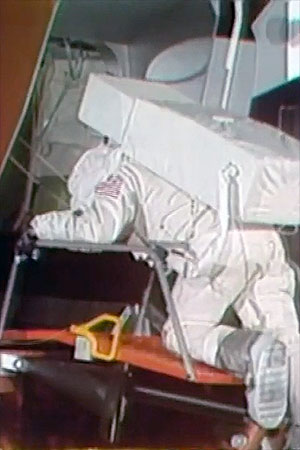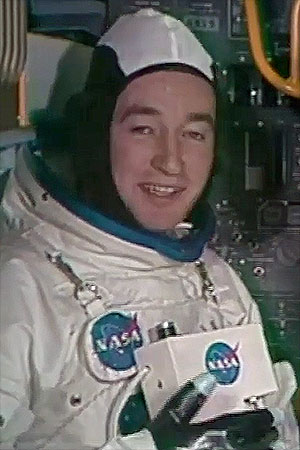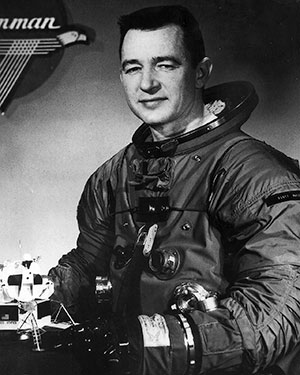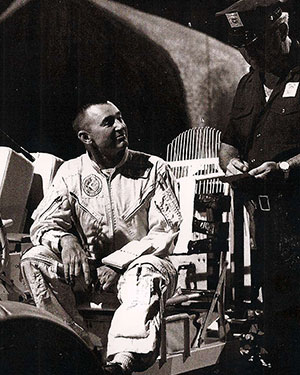August 16, 2021 — Scott MacLeod was never an Apollo astronaut, but he did play one on TV.
If you were among the millions who tuned in for CBS's live coverage of NASA's moon missions from 1969 through 1972, you no doubt saw MacLeod, clad in a spacesuit and standing inside a lunar module simulator to provide Walter Cronkite with play-by-play descriptions of every move the real astronauts were making.
"We might go out now to Grumman Aircraft in Bethpage, Long Island, where ... test astronaut Scott MacLeod is in the simulated lunar module," said Cronkite, introducing one such segment during the Apollo 9 mission in 1969. "Perhaps [he] can tell us a little bit more about what we have just seen on television from the spacecraft itself."
What those watching may have been unaware of at the time, or forgotten since, is why MacLeod was there. Cronkite referred to MacLeod as a "test astronaut," not as an actor or stand-in, hinting that what MacLeod did for the Apollo program went well beyond providing color commentary on TV.
As a lunar module test engineer at Grumman, it was MacLeod's job to know as much about operating the lunar module as the Apollo astronauts themselves. How he attained that role was by no means an accident; MacLeod was one of the most experienced test pilots at Grumman in the 1960s.
From Skyhawk to 'Spider'
A U.S. Navy fighter pilot whose interest in aviation took off (literally) at age 9, when he had the chance to fly on a bi-plane flight with the second pilot to fly nonstop across the Atlantic Ocean, MacLeod first flew into combat the end of World War II.
Upon his return to the States, MacLeod took advantage of the GI Bill and earned several degrees, including aeronautical engineering from Rensselaer Polytechnic Institute, physics from Wesleyan University and mathematics from the University of Virginia. Some of the degrees were obtained in night school while he worked as an aeronautical research scientist for NACA (the National Advisory Committee for Aeronautics) at Langley Field in Virginia.
When the Korean War began, MacLeod wanted to go back to flying combat. Much to the disappointment of his boss at the time, Scott resigned his position at NACA, the predecessor agency to NASA, and rejoined the Navy, serving as a carrier-based pilot aboard the USS Kearsarge flying the Grumman F9F Panther in close air support.
By 1954, Scott was based in San Diego, conducting test flights for the Navy in the then-new Douglas A4 Skyhawk. A year later, MacLeod met a Grumman manager, who convinced him to leave the service and join Grumman as a test engineer and pilot in New York.
When Grumman won NASA's competition to build the Apollo lunar module in 1962, it looked no further than its already capable cadre of test pilots to assist with designing the moon lander's cockpit. Around 1964, Macleod, along with several other Grumman pilots already working preliminary design on the new F-14, joined Grumman's effort as "lunar module consultant pilots." These men, most of whom had flown every plane Grumman made going back to World War II, would become a key conduit between NASA's astronauts and Grumman's engineers, providing a "pilot's eye" to interior design considerations.
Stand-up job
It was in this period, from 1964 to when the first crewed lunar module launched on the Apollo 9 mission five years later, that major design changes were made to the four-legged lander, both structurally and in the overall design of the pilot interface. It fell to MacLeod and his fellow consulting pilots to assist with the development of critical pilot interface systems in the lunar module cockpit.
Weight was a key concern and only the necessities were kept in the spacecraft's cabin. Out went the seats, for example, as they were deemed unnecessary in a microgravity or low-G environment, only adding weight and volume to an already cramped volume. The basic roles of the two crew members, however, did not change. One side of the cabin was dedicated to controlling the linear motion of the vehicle, with a joystick controlling the forward, aft and starboard motion, while the other side was for lateral control — pitch, roll and yaw.
As far as MacLeod and his fellow consulting pilots were concerned, the lunar module was as much a flying machine as any other vehicle built in the Grumman factory. In fact, it became the only human spacecraft that would ever be built by Grumman Aircraft.
As the flight-ready lunar modules started coming off the assembly line, especially those that would carry astronauts, MacLeod began taking on the job of the astronaut in the cockpit, conducting the final tests and checkouts. As it turns out, it was that role that most interested the producers at CBS.
One small simulated step
When Apollo 8 became the first mission to circle the moon in December 1968, CBS provided nearly non-stop coverage of the mission, from the crew's launch to splashdown. Besides anchor Walter Cronkite, the other on-camera talent seen throughout most of the live broadcast was a test engineer from North American Aviation (NAA) in Downey, California.
Sitting inside a full-scale mock-up of the NAA-built Apollo command module, Leo Krupp described and performed for viewers the same procedures that were being executed in lunar orbit by astronauts Frank Borman, Jim Lovell and Bill Anders.
When the time came to plan the coverage for Apollo 9, CBS sought a counterpart for Krupp at Grumman, performing the same demonstrations in the lunar module. The job fell to MacLeod, who joined CBS's coverage of Apollo 9 and every mission to follow, providing the public with insight into the lunar module and the astronauts' activities that was absent from the competing networks' news broadcasts.
On July 20, 1969, as Neil Armstrong exited the Apollo 11 lunar module to take his first "small step," MacLeod, dressed in a spacesuit similar to what Armstrong was wearing, climbed down the ladder of Grumman's full-size mock-up lunar module in Bethpage. His descent to a simulated lunar surface allowed CBS to show in color what was happening until Armstrong deployed a camera and began broadcasting grainy black and white footage from the moon.
While waiting for Armstrong and Buzz Aldrin to begin the moonwalk, MacLeod answered Cronkite's questions as to why it might be taking longer than expected.
"Trying to do this in here, in one-G, with help from our friendly technicians has been very difficult," said MacLeod, describing donning the costume spacesuit. "To try to do it up there, in one-sixth-G, with just the two of them, I am sure how been extremely difficult."
MacLeod continued making appearances on CBS through the follow-on flights, including demonstrating Apollo 15 commander David Scott's "stand-up" EVA, when the upper hatch of the lunar module was opened shortly after touching down on the moon to survey the landing site. Since this happened before Scott or Jim Irwin could deploy a TV camera on the lunar surface, MacLeod's reenactment was the only live visual for the event.
As the last lunar landing mission, Apollo 17, left the moon, CBS viewers saw the last of MacLeod. With no more lunar modules needing testing, Grumman began disbanding its team. MacLeod, along with several of his fellow consultant pilots, stayed on with Grumman to fly the F-14 Tomcat, but by the mid-1970's, MacLeod left the company to become a consultant for U.S. government agencies.
MacLeod died on April 12 of this year, at the age of 95. |
|

Grumman test astronaut Scott MacLeod exits a mock lunar module in Bethpage, New York during CBS' live coverage of the Apollo 11 moon landing anchored by Walter Cronkite on July 20, 1969. (CBS)

Grumman consulting pilot, clad in a spacesuit costume, provided a play-by-play account of the Apollo moon missions from inside a mock lunar module for Walter Cronkite's live CBS coverage. (CBS)

Portrait of lunar module consulting pilot Scott MacLeod. (Grumman)

During a break in filming for CBS, Scott MacLeod poses for a photo with a lunar rover trainer and Grumman security guard. The photo shows the first documented case of a speeding ticket being written on the lunar surface! (Grumman) |
